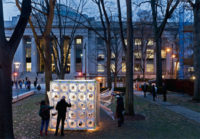Julia Morgan's impressive legacy of architectural achievements from her 45-year practice in San Francisco has won her the AIA Gold Medal for 2014.
| Photo © Richard Barnes |
| Studies in Paris would lead Julia Morgan to the playful Bear House at Wyntoon in California (1933). |
The well-publicized announcement that Julia Morgan (1872–1957) is the recipient of the American Institute of Architects' Gold Medal for 2014—the first woman to receive the honor—naturally raises questions about why it took so long. She died 57 years ago. (We also might wonder about the logic of posthumous Gold Medals—but more about that later.) Whatever the nature of the debate, there should be no question about Morgan's deserving the award given “in recognition of a significant body of work of lasting influence on the theory and practice of architecture.”
To begin with, we must acknowledge Morgan's historic role in a male-dominated profession: she was the first female to graduate from the highly prestigious architecture program at the Ecole des Beaux-Arts in Paris in 1902. After Morgan returned to her hometown of Oakland, California, she was the first female in the state to get her license. Then, in 1904, she became the first registered female architect to establish a full-time independent practice in the United States, according to biographer Mark A. Wilson. And she was (posthumously) the first woman to be inducted into the California Hall of Fame in 2008, two years after it was created.
The sheer output of Morgan's work—over 700 buildings, including schools, libraries, community centers, churches, and commercial buildings, not to mention houses—surpasses the achievements of her male and female peers. Frank Lloyd Wright, who completed 532 works of architecture during his lifetime, seems almost a slacker in comparison. Morgan, who never married, could undertake these projects without family responsibilities. But running an office of 8 to 10 men and women to do all this must have been grueling. And Morgan didn't just churn out buildings: her best-known work, Hearst Castle in San Simeon, the estate commissioned by William Randolph Hearst, took several decades to complete: site work started in 1919, and she spent at least 25 years on it.
The medal recognizes more than Morgan's significance as a role model; it acknowledges her technical and artistic accomplishments in architecture, including her pioneering forays into reinforced-concrete construction. Morgan, who graduated with a civil engineering degree in 1894 from Berkeley before going off to Paris, joined the office of John Galen Howard upon her return to the West Coast. He soon put her in charge of supervising the design and construction of the reinforced-concrete Greek Theater (1903) on the Berkeley campus, for which he was the master planner.
Not long after, Morgan opened her own office. Her early projects included a bell tower, out of reinforced concrete, El Campanil, for Mills College (1904)—along with the stately concrete Margaret Carnegie Library for the campus (1906), and the Hicks House in Berkeley (1906), later remodeled by another architect. Her explorations with this new material were contemporaneous with those of Auguste Perret, himself a student at the Ecole in the 1890s and an AIA Gold Medalist in 1952, who finished his concrete apartment building at 25 bis Rue Franklin in Paris in 1904.
Morgan's bold combination of architecture and engineering know-how could be seen in her use of exposed wood beams, struts, and trusses in any number of her projects, almost all in California. She immersed herself in a vernacular tradition that Bernard Maybeck (Gold Medalist, 1951)—with whom she studied and worked before going to Paris—was developing into a regional expression dubbed the First Bay Tradition. Based on the English Arts and Crafts movement, it placed an emphasis on natural materials from local sources, along with craftsmanship and the careful siting of architecture in the landscape. Morgan's sturdily elegant churches, graciously simple YWCA buildings, and other cultural centers in particular present striking examples of this sensibility—although the exposed wood beams and trusses of her roofs arguably adhered to the structural rationalism of French 19th-century thinking. In his letter of support for Morgan's nomination, Frank Gehry commended her for “expressing structure in new ways.”
At Morgan's Asilomar YWCA-commissioned conference center in Pacific Grove (1913–28), a sturdily elegant Merrill Hall features 23-foot-long Douglas fir beams and Gothic arches creating an open-truss structure for the 800-seat room. As Denise Scott Brown noted in her recommendation to the AIA board, “Morgan's larger buildings were masterful exercises in modest monumentality and tender gravitas, beautifully executed.”
Morgan also showed a remarkable ease in synthesizing historic styles, as we see at Wyntoon, a vacation retreat for the Hearst family in California near Mount Shasta, completed between 1924 and 1935. Here Medieval German or Austrian architectural motifs, combined with frescos by Willy Pogany on the Bear House (1933), endow the cottage with a story-book quality in an ultra-picturesque setting.
The plethora of commissions from repeat clients such as Phoebe Hearst and her son William obviously helped Morgan's practice: the latter's Hearst Castle, then called La Cuesta Encantada (Enchanted Hill), is clearly the most sumptuous of her works. While it doesn't appear to be advanced architecturally, the poured-concrete structure, where Renaissance and Baroque architectural motifs from southern Spain create an exotic setting, is suffused by a superb sense of proportion, color, texture, and composition.
For Morgan to get the Gold Medal would seem a slam dunk. Yet it took an extreme effort to organize the campaign, which was spearheaded by Julia Donoho, an AIA board member representing California. Donoho seems to have been sent from on high to carry this out: both an architect and an attorney, she had started out studying engineering at Princeton University before switching to its architecture school for both her bachelor's and her master's degrees.
After practicing architecture, Donoho earned a juris doctorate from Empire College in Santa Rosa—small wonder she approached the task of nominating Morgan as if it were a court case. Donoho garnered support within the AIA, put together an impressive packet of materials, sought letters from prominent professionals (including Michael Graves, as well as Gehry and Scott Brown), and asked one of the country's most innovative female practitioners, Jeanne Gang, to present Morgan's nomination to the AIA Board.
While the mission ended successfully, a posthumous award has raised questions about whether the Gold Medal should be given to those who are no longer with us. Some wonder why such an honor should not go to those who can appreciate it and be gratified by peer recognition. According to Richard Guy Wilson, who wrote The AIA Gold Medal in 1984 and an updated essay on the topic in 2008, the honor was modeled on the Royal Institute of British Architects' Royal Gold Medal, which is not bestowed posthumously. Indeed, in the AIA's case, the first three posthumous awards were accidental: they had been decided on just before the recipients' deaths, including that of Charles Follen McKim, in 1909, who had conceived the program in 1907. Over the years, more posthumous awards were given, often to architects struck down in the prime of their careers (such as Bertram Goodhue, Eero Saarinen, Samuel Mockbee), or were bestowed as belated historical recognition—for example to Louis Sullivan, and, of course, to Morgan, who had been preceded by 11 men, according to Wilson's count.
Considering that the practice of giving the Gold Medal posthumously has become somewhat of a custom by now, it is especially fitting for Morgan to receive it. Perhaps a better idea would be to establish a pantheon of deceased distinguished American architects (which could include non–Gold Medalists, such as Benjamin Latrobe). But this idea would not ease the immense amount of work that needs to be done to get a nomination through the complex selection process as it stands now. To be sure, this extreme effort, where the living architect submits credentials (and the dead need tireless proponents) could be debated as well. But that's another story.












Post a comment to this article
Report Abusive Comment